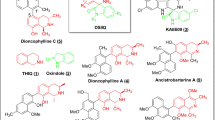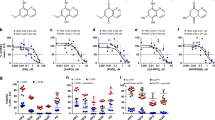Abstract
The discovery of artemisinin more than 30 years ago provided a completely new antimalarial structural prototype; that is, a molecule with a pharmacophoric peroxide bond in a unique 1,2,4-trioxane heterocycle1. Available evidence2,3,4 suggests that artemisinin and related peroxidic antimalarial drugs exert their parasiticidal activity subsequent to reductive activation by haem, released as a result of haemoglobin digestion by the malaria-causing parasite. This irreversible redox reaction produces carbon-centred free radicals, leading to alkylation of haem5 and proteins (enzymes)6, one of which—the sarcoplasmic-endoplasmic reticulum ATPase PfATP6 (ref. 7)—may be critical to parasite survival. Notably, there is no evidence of drug resistance to any member of the artemisinin family of drugs8. The chemotherapy of malaria has benefited greatly from the semi-synthetic artemisinins artemether and artesunate as they rapidly reduce parasite burden, have good therapeutic indices and provide for successful treatment outcomes9. However, as a drug class, the artemisinins suffer from chemical10 (semi-synthetic availability, purity and cost), biopharmaceutical11 (poor bioavailability and limiting pharmacokinetics) and treatment8,11 (non-compliance with long treatment regimens and recrudescence) issues that limit their therapeutic potential. Here we describe how a synthetic peroxide antimalarial drug development candidate was identified in a collaborative drug discovery project.
This is a preview of subscription content, access via your institution
Access options
Subscribe to this journal
Receive 51 print issues and online access
$199.00 per year
only $3.90 per issue
Buy this article
- Purchase on Springer Link
- Instant access to full article PDF
Prices may be subject to local taxes which are calculated during checkout



Similar content being viewed by others
References
Klayman, D. L. Qinghaosu (artemisinin): an antimalarial drug from China. Science 228, 1049–1055 (1985)
Jefford, C. W. Why artemisinin and certain synthetic peroxides are potent antimalarials. Implications for the mode of action. Curr. Med. Chem. 8, 1803–1826 (2001)
Cumming, J. N., Polypradith, P. & Posner, G. H. Antimalarial activity of artemisinin (qinghaosu) and related trioxanes: mechanism(s) of action. Adv. Pharmacol. 37, 254–297 (1997)
Wu, Y. How might qinghaosu (artemisinin) and related compounds kill the intraerythrocytic malaria parasite? A chemist's view. Acc. Chem. Res. 35, 255–259 (2002)
Robert, A., Coppel, Y. & Meunier, B. Alkylation of heme by the antimalarial drug artemisinin. Chem. Commun., 414–415 (2002)
Meshnick, S. R. Artemisinin: mechanisms of action, resistance and toxicity. Int. J. Parasitol. 32, 1655–1660 (2002)
Eckstein-Ludwig, U. et al. Artemisinins target the SERCA of Plasmodium falciparum. Nature 424, 957–961 (2003)
White, N. J. Antimalarial drug resistance and combination chemotherapy. Phil. Trans. R. Soc. Lond. B 354, 739–749 (1999)
White, N. J. Assessment of the pharmacodynamic properties of antimalarial drugs in vivo. Antimicrob. Agents Chemother. 41, 1413–1422 (1997)
Avery, M. A., Chong, W. K. M. & Jennings-White, C. Stereoselective total synthesis of (+ )-artemisinin, the antimalarial constituent of Artemisia annua L. J. Am. Chem. Soc. 114, 974–979 (1992)
Ridley, R. G. Medical need, scientific opportunity and the drive for antimalarial drugs. Nature 415, 686–693 (2002)
Nwaka, S. & Ridley, R. G. Virtual drug discovery and development of neglected diseases through public-private partnerships. Nature Rev. Drug Discov. 2, 919–928 (2003)
Desjardins, R. E., Canfield, C. J., Haynes, J. D. & Chulay, J. D. Quantitative assessment of antimalarial activity in vitro by a semiautomated microdilution technique. Antimicrob. Agents Chemother. 16, 710–718 (1979)
Ridley, R. G. et al. Antimalarial activity of the bisquinoline trans-N1, N2-bis-(7-chloroquinolin-4-yl)cyclohexane-1,2-diamine: Comparison of two stereoisomers and detailed evaluation of the S,S enantiomer, Ro 47–7737. Antimicrob. Agents Chemother. 41, 677–686 (1997)
Abe, M., Inakazu, T., Munakata, J. & Nojima, M. 18O-Tracer studies of Fe(ii)-induced decomposition of 1,2,4-trioxolanes (ozonides) derived from cyclopentenes and indenes. Inner-sphere electron transfer reduction of the peroxide linkage. J. Am. Chem. Soc. 121, 6556–6562 (1999)
van de Waterbeemd, H., Smith, D. A., Beaumont, K. & Walker, D. K. Property-based design: Optimisation of drug absorption and pharmacokinetics. J. Med. Chem. 44, 1313–1333 (2001)
Smith, D., Jones, B. C. & Walker, D. K. Design of drugs involving concepts and theories of drug metabolism and pharmacokinetics. Med. Res. Rev. 16, 243–266 (1996)
Palm, K., Stenberg, P., Luthman, K. & Artursson, P. Polar molecular surface properties predict the intestinal absorption of drugs in humans. Pharm. Res. 14, 568–571 (1997)
Lipinski, C. A., Lombardo, F., Dominy, B. W. & Feeney, P. J. Experimental and computational approaches to estimate solubility and permeability in drug discovery and development settings. Adv. Drug Deliv. Rev. 23, 3–26 (1997)
Veber, D. F. et al. Molecular properties that influence the oral bioavailability of drug candidates. J. Med. Chem. 45, 2615–2623 (2002)
Griesbaum, K., Liu, X., Kassiaris, A. & Scherer, M. Ozonolyses of O-alkylated ketoximes in the presence of carbonyl groups: a facile access to ozonides. Liebigs Ann./Recueil., 1381–1390 (1997)
Tang, Y., Dong, Y. & Vennerstrom, J. L. Synthetic peroxides as antimalarials. Med. Res. Rev. 24, 425–448 (2004)
Vennerstrom, J.L., Dong, Y., Chollet, J. & Matile, H. Spiro and dispiro 1,2,4–trioxolane antimalarials. US patent 6, 486,199 (2002).
Vennerstrom, J.L. et al. Spiro and dispiro 1,2,4-trioxolane antimalarials. US continuation-in-part based on PCT/US02/19767 (filed 21 June 2002).
Chawira, A. N. & Warhurst, D. C. The effect of artemisinin combined with standard antimalarials against chloroquine-sensitive and chloroquine-resistant strains of Plasmodium falciparum in vitro. J. Trop. Med. Hyg. 90, 1–8 (1987)
Li, A.-G. et al. The pharmacokinetics and bioavailability of dihydroartemisinin, arteether, artemether, artesunic acid and artelinic acid in rats. J. Pharm. Pharmacol. 50, 173–182 (1998)
Vyas, N., Avery, B. A., Avery, M. A. & Wyandt, C. M. Carrier-mediated partitioning of artemisinin into Plasmodium falciparum-infected erythrocytes. Antimicrob. Agents Chemother. 46, 105–109 (2002)
Gordi, T. & Lepist, E.-I. Artemisinin derivatives: Toxic for laboratory animals, safe for humans? Toxicol. Lett. 147, 99–107 (2004)
Keul, H. Über konstitution und entstehung der ozonide von bis-adamantyliden und von bis-bicyclo[3.3.1]non-9-yliden. Chem. Ber. 108, 1207–1217 (1975)
Crespi, C. L., Miller, V. P. & Penman, B. W. Microtiter plate assays for inhibition of human, drug-metabolizing cytochromes P450. Anal. Biochem. 248, 188–190 (1998)
Acknowledgements
We thank R. G. Ridley and M. Tanner for inspiration; K. Griesbaum and A. Hudson for advice; C. Craft, S. Nwaka, S. Campbell, P. Hadvary and R. Imhof for their support; and J. M. Karle for performing X-ray crystallographic experiments. This work was supported by the World Health Organization and Medicines for Malaria Venture.
Author information
Authors and Affiliations
Corresponding author
Ethics declarations
Competing interests
The authors declare that they have no competing financial interests.
Supplementary information
Supplementary Data
This file contains a detailed Methods section with a complete description of the reaction of trioxolane 4 with ferrous acetate/TEMPO; Supplementary Table 1 (in vivo activity in P. berghei infected mice following a, single oral doses or b, three consecutive daily oral doses of trioxolanes 5–7 and the four comparator drugs), Table 2 (prophylactic activity following single 100 mg/kg oral doses of trioxolane 6 and 7 and the four comparator drugs) and Table 3 (in vitro cross-resistance (IC50, IC90) for trioxolanes 6 and 7, AS, and CQ with various strains of P. falciparum); and the legend to Supplementary Figure 1. (DOC 72 kb)
Supplementary Figure 1
This figure shows plasma concentration versus time profiles following oral administration of trioxolanes 6 and 7, AM, and AS to rats. (PDF 40 kb)
Rights and permissions
About this article
Cite this article
Vennerstrom, J., Arbe-Barnes, S., Brun, R. et al. Identification of an antimalarial synthetic trioxolane drug development candidate. Nature 430, 900–904 (2004). https://doi.org/10.1038/nature02779
Received:
Accepted:
Issue Date:
DOI: https://doi.org/10.1038/nature02779
This article is cited by
-
Capturing primary ozonides for a syn-dihydroxylation of olefins
Nature Chemistry (2023)
-
Synthesis and antimalarial activity of amide and ester conjugates of siderophores and ozonides
BioMetals (2023)
-
Quantitative analysis of doxorubicin hydrochloride and arterolane maleate by mid IR spectroscopy using transmission and reflectance modes
BMC Chemistry (2021)
-
In vivo anti-malarial activity of the hydroalcoholic extract of rhizomes of Kniphofia foliosa and its constituents
Malaria Journal (2021)
-
An in vitro toolbox to accelerate anti-malarial drug discovery and development
Malaria Journal (2020)
Comments
By submitting a comment you agree to abide by our Terms and Community Guidelines. If you find something abusive or that does not comply with our terms or guidelines please flag it as inappropriate.



